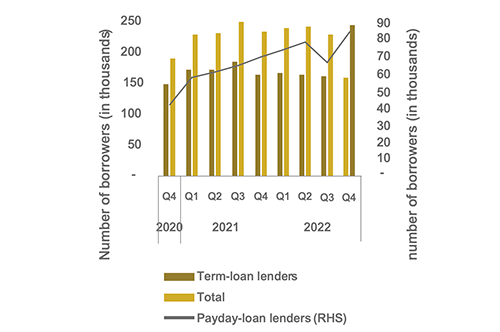The cumulative number of household borrowers in Namibia increased by 6.9% quarter-on-quarter and by 4.5% year-on-year to 244 697 beneficiaries by December 2022.
This, according to analysts, signifies the desperate economic environment domestic households find themselves in, which has been exacerbated by escalating prices of goods and services, as well as constantly rising interest rates.
The Namibia Financial Institutions Supervisory Authority (Namfisa), noted the increase in the number of borrowers was reflected in the category of household borrowers transacting with payday lenders.
“The category of household borrowers transacting with payday lenders rose by 27.9% quarter-on-quarter and by 23.3% year-on-year, over the same period. Despite this observed increase, the number of term borrowers remained greater than the number of payday borrowers in relation to the total number of household borrowers at the end of the period under review,” reads Namfisa’s fourth quarter bulletin released this month.
Namfisa is an independent institution established to regulate and supervise financial institutions in the financial services industry in the public interest. The authority is fully funded by levies imposed on the financial services industry.
Furthermore, at the end of the fourth quarter of 2022, a downward trend was observed in the value of arrears.
As a result, the financial services regulator stated that arrears declined by 10.2% quarter-on-quarter to N$1.3 billion.
Relative to the value of the loan book, arrears as a percentage of the loan book stood at 20% at the end of the review period, while the amount due in the same period stood at 80%.
The report further highlighted that arrears for term borrowers stood at N$1.3 billion at the end of the fourth quarter of 2022, accounting for 20.3% of the value of the loan book for term lenders.
“Arrears for term lenders decreased by 10.2% on a quarterly basis over the same period. The age category of 120 days+ accounted for the largest amount of the total arrears at 13%. The second largest age category is the age category of 30 to 60 days, which accounted for 6%,” said Namfisa.
Meanwhile, arrears for payday borrowers stood at N$56 million, accounting for 23.3% of the loan book value, while 76.7% accounted for payments due in the fourth quarter of 2022.
Furthermore, arrears for payday lenders declined quarter-on-quarter by 9%. The age category of 120 days+ accounted for the largest amount of total arrears, which stood at 15% for the end of the fourth quarter of 2022.
Moreover, according to the financial stability report for 2022 released by the Bank of Namibia (BoN) and Namfisa, households’ debt servicing costs almost doubled from 2020 to 2022.
“The household debt servicing costs increased from 9% in 2020 to 17.8% in 2022, reflecting a combination of higher debt levels as well as high-interest rates. Although households are highly indebted, the majority of their debt is secured lending, of which mortgage lending accounts for most of it,” reads the financial report released by the two entities in April 2023.
The household sector in Namibia accounts for the majority of private sector credit extended. It is, therefore, an important participant in the domestic financial system, accounting for almost 58% of total private sector credit extended by the banking sector over the past five years.


